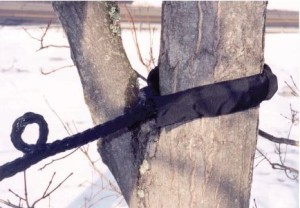Introduction
Trees are naturally strong, organic, growing structures. The ability of trees to withstand the environmental forces placed on them is a wonder of natural engineering unique to the world of trees. Trees, the largest of plants, have developed over time unique abilities to reach high above the ground to harvest the sunlight and oxygen from our atmosphere. Trees are capable of supporting themselves under most circumstances. However, occasionally nature interferes or abnormalities develop. When this happens, a tree will need supplemental support to help keep it beautiful and upright.
Cabling
Cabling is a method of installing, high in the tree, steel or synthetic support cables. These systems reduce loads on the branch and stem unions of the tree that may be weak or split. Installed properly, the cables are unobtrusive, long lasting and effective in adding years or decades to the stability of your trees. Cabling can come in many shapes and forms, depending on each situation. It is important to match a specific system to the tree and its structure. Some trees require only one cable, others may need several.
Steel is a common material for cabling systems. High strength steel systems are rigid and restrict movement. They reinforce/replace the tree’s branch union, but at a much higher point than the tree can or would be able to grow naturally.
 A complex steel spoke and hub system
A complex steel spoke and hub system
 Synthetic cabling system
Synthetic cabling system
More flexible synthetic systems are also available and offer options. Synthetic systems can be less invasive and allow the tree to form reactive wood and help strengthen itself. They limit the range of movement, but cannot pull broken/split pieces back together. Both steel and synthetic systems have a place. However, they must be used properly with the ultimate goal being tree health and structural stability. Cabling systems are sometimes all that is needed. If more support is needed the next step is taken, bracing.
Bracing
Bracing is the process of inserting rods or bolts through the trunk of the tree to help form a foundation of support. These rods  are always used in conjunction with a cabling system high above. Bracing rods provide additional support to cracked, split or unjoined branch and stem unions. The rods immediately help “hold” things together. As the tree grows around them, they become even more supportive. In very few cases with very small trees, rods may be used alone, but this is rare. Bracing rods are by their very nature invasive as they require a hole to be drilled through the tree. The stems being supported must also retain enough strength to handle the force applied at the ends of the rods where washers and nuts are placed.
are always used in conjunction with a cabling system high above. Bracing rods provide additional support to cracked, split or unjoined branch and stem unions. The rods immediately help “hold” things together. As the tree grows around them, they become even more supportive. In very few cases with very small trees, rods may be used alone, but this is rare. Bracing rods are by their very nature invasive as they require a hole to be drilled through the tree. The stems being supported must also retain enough strength to handle the force applied at the ends of the rods where washers and nuts are placed.
When to say when
Not all trees are good candidates for a cabling or bracing system. Poor candidates include trees with compromised root systems or trees with major defects in the static relevant zone. (This is the section of a tree encompassing an area three feet out from the buttress roots of the tree into the root system and vertically all the way to the first major branches.) In these situations, a cabling and bracing system may place excessive force on the stems and root system of the tree, causing the whole tree to fall. Some trees, due to rot or decay, may not have the structural ability to hold the necessary anchors in place. The cabling or bracing system may be installed, but be ineffective since the anchor points it relies on are weaker than the system or the natural forces applied. However, more often than not a cabling and/or bracing system can be safely and effectively installed. In cases of minor cracks and splits or genetic abnormalities, these techniques can add decades to a tree’s productive life. In the case of historic or exceptional trees, cabling and bracing systems can mitigate hazards and increase health, by limiting breakage in the canopy.
Conclusions
The installation of cabling and bracing systems is invasive. However, it is often worth the effort to help mitigate risk and/or hazard, as well as prolong the stability of feature trees. It should never be considered a cure. These systems are hazard and breakage mitigators. The best system our human minds can conceive and install can be destroyed in a moment by an exceptional environmental occurrence! Cabling and bracing systems can and do help under normal circumstances. Trees can be preserved and their beauty enjoyed for generations to come with proper installation, inspection and maintenance. Like the trees the trees they protect, these systems do not last forever. Care and diligence are required to keep cabling and bracing systems in tip-top shape.